Fujitsu Technology Solutions SCENIC6651 Personal Computer User Manual A26361 K520 Z200 1 7619
Fujitsu Technology Solutions GmbH Personal Computer A26361 K520 Z200 1 7619
Contents
- 1. Manual Scenic 600 Oct 99 part 1
- 2. Manual Scenic 600 Oct 99 part 2
- 3. Manual Scenic 600 Oct 99 part 3
- 4. Manual Scenic 600 Oct 99 part 4
- 5. Manual Scenic 600 Oct 99 part 5
- 6. Manual Scenic 600 Oct 99 part 6
- 7. Manual Scenic 600 Oct 99 part 7
- 8. Scenic 600 Scenic xB May 2000 part1
- 9. Scenic 600 Scenic xB May 2000 part2
- 10. Scenic 600 Scenic xB May 2000 part3
- 11. Scenic 600 Scenic xB May 2000 part4
Scenic 600 Scenic xB May 2000 part2

A26361-K520-Z200-1-7619 9
Preparation for use and operation
!Please take note of the safety information in the chapter "Important notes".
Unpacking and checking the delivery
It is recommended not to throw away the original packaging material! It may be required for
reshipment at some later date.
Ê Unpack all the individual parts.
Ê Check the delivery for damage incurred during transportation.
Ê Check whether the delivery agrees with the details in the delivery note.
Should you discover that the delivery does not correspond to the delivery note, notify your local
sales outlet immediately.
i
If you have received drives or boards with your PC, please do not install them until after
first-time setup. How to install drives and boards is described in the chapter "System
expansions".
Steps for initial setup
First-time setup includes the connection of the devices (monitor, mouse, keyboard etc.) and the
setup of the supplied software.
When you set up the PC for the first time, you should carry out the following steps in the order
shown:
1. Decide where you are going to use the PC.
2. Connect the external devices to the system unit.
3. Check the rated voltage of the system unit and connect it to the line voltage.
4. Switch the PC on and follow the instructions on the screen.

Preparation for use and operation Setting up the PC
10 A26361-K520-Z200-1-7619
Setting up the PC
!When installing your PC, give consideration to the recommendations and safety notes in
the manual "Safety, Guarantee and Ergonomics".
Set up the PC only in its correct orientation. The points to observe are illustrated on the
following pages.
We recommend that you place your equipment on a surface with good anti-slip qualities.
In view of the multitude of different finishes and varnishes used on furniture, it is possible
that the rubber feet of the devices will mark the surface they stand on.
Do not expose the PC to extreme environmental conditions (see chapter "Technical
data"). Protect it from dust, humidity and heat.
Provide at least 200 mm of clearance on the left, in front of and behind the ventilator area
of the system unit to ensure adequate ventilation. Do not cover the ventilation areas of the
monitor and the system unit.
Do not place any objects that weigh more than 40 kg on the system unit and not several
system units one above the other.
Connecting devices
!The power plug must be disconnected!
Read the documentation on the external device before connecting it.
Do not connect or disconnect cables during a thunderstorm.
Always take hold of the actual plug body. Never unplug a cable by pulling the cable itself.
Connect and disconnect the cables in the order described below.
Connecting cables
• Turn off all power and equipment switches.
• Unplug all power plugs from the grounded power outlets.
• Connect all cables at the system unit and peripherals. You must observe the information
provided in the chapter "Important notes".
• Plug all data communication cables into the utility sockets.
• Plug all power cables into the grounded power outlets.
Disconnecting cables
• Turn off all power and equipment switches.
• Unplug all power plugs from the grounded power outlets.
• Unplug all data communication cables from the utility sockets.
• Disconnect all cables from the system unit and peripherals.
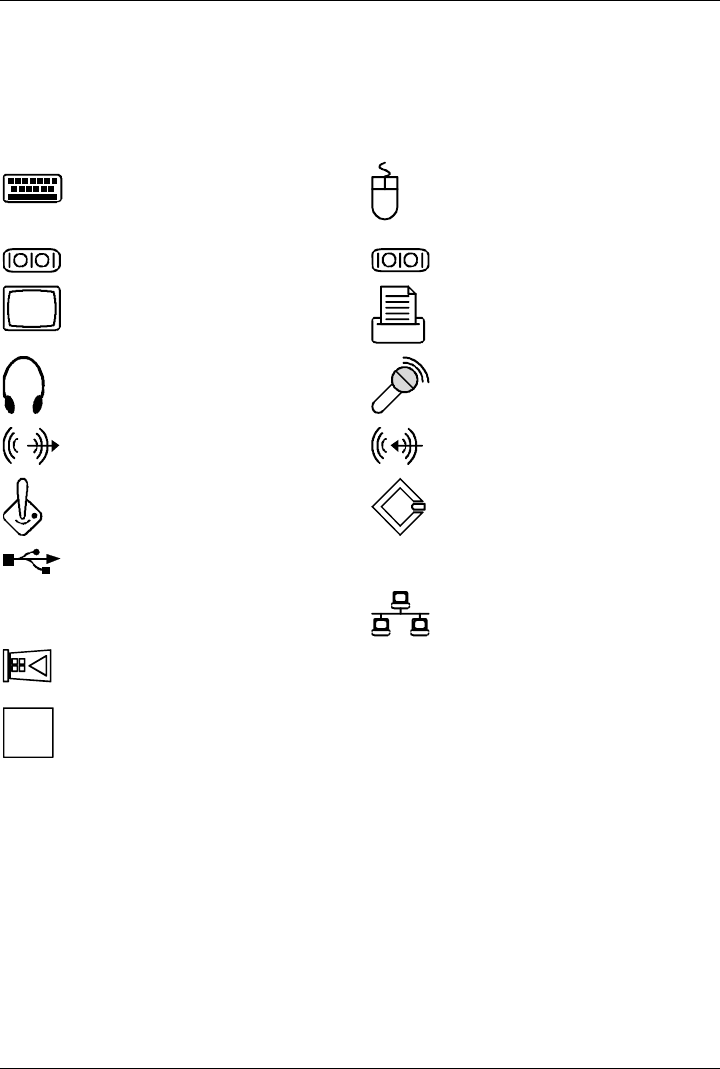
Connecting devices Preparation for use and operation
A26361-K520-Z200-1-7619 11
Ports for external devices
The ports for external devices are on the rear and on the front of the system unit. The ports
available on your device depend on the configuration level you have selected. The standard ports
are marked with symbols like those below or similar symbols. Exact details of the position of the
ports are supplied in the Technical Manuals for the boards.
Keyboard port / purple PS/2 mouse port / green
1Serial interface 1 / teal or turquoise 2Serial interface 2 / teal or turquoise
Monitor port / blue Parallel interface / Printer / burgundy
Headphones port / orange Microphone jack (mono) / pink
Audio output (Line out) / lime Audio input (Line in) / light blue
Game port / gold SCSI connection
USB - Universal Serial Bus / black
L
AN LAN port
Chipcard reader
i
Some of the devices that you connect require special drivers (see the documentation for
the connected device and for the operating system).
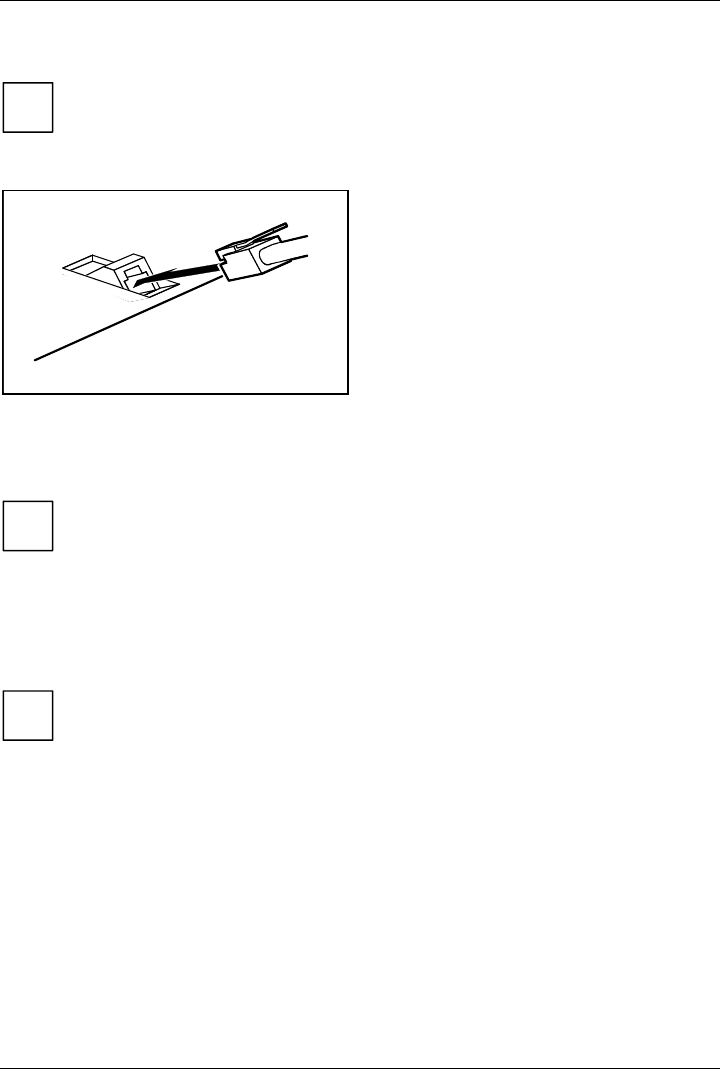
Preparation for use and operation Connecting devices
12 A26361-K520-Z200-1-7619
Connecting the keyboard
i
Use only the keyboard cable supplied.
Ê Plug the round plug of the keyboard cable into the keyboard port on the system unit.
Ê Plug the other connector of the keyboard
cable into the socket on the underside of
the keyboard.
Connecting the mouse
Ê Plug the connector of the mouse cable into the mouse port.
i
If you do not attach a mouse at the PS/2 mouse port, you can disable the mouse
controller in the BIOS Setup in order to free the IRQ12 for a different application.
Connecting devices with serial or parallel port
Ê Connect the data cable to the external device.
Ê Connect the data cable of the external device to the appropriate port on the system unit.
i
Most devices that you connect to the serial or parallel port require special drivers. Your
operating system already includes many drivers . But if the driver you need is not on the
hard disk please install it from the floppy disk supplied with the device or with the
application program.
If you need to change the default settings of the serial or parallel port (e. g. address,
interrupt), you can do so in the BIOS Setup. The default setting for the interfaces are
described in the Technical Manual for the system board or in the "BIOS Setup" manual.
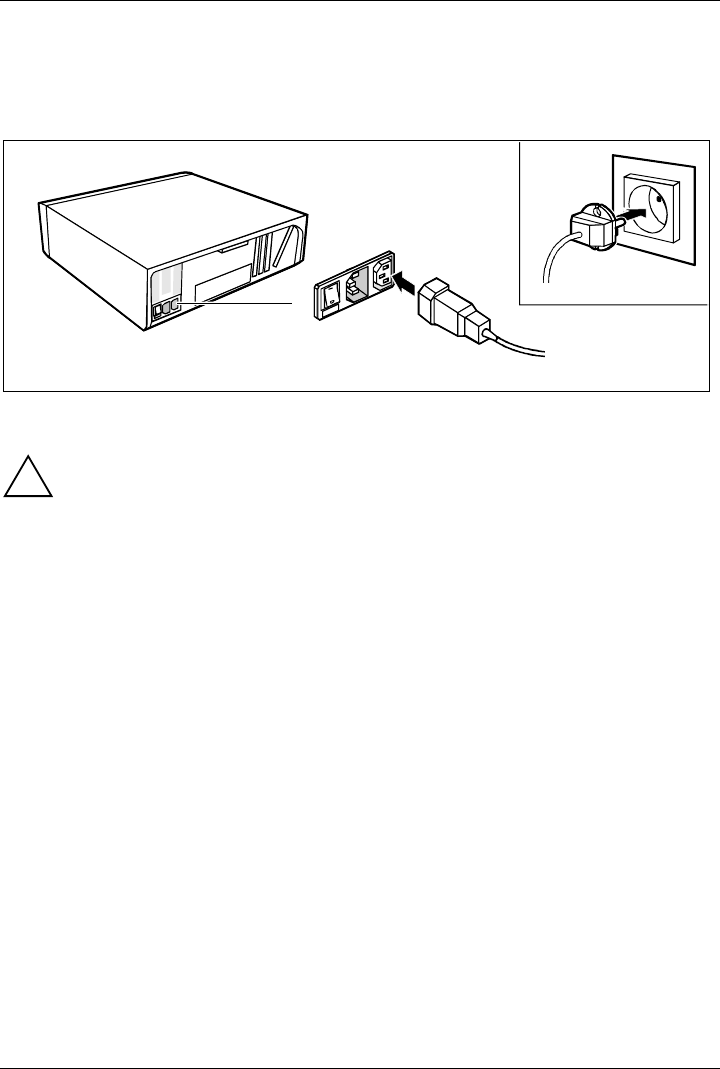
Connecting devices Preparation for use and operation
A26361-K520-Z200-1-7619 13
Connecting the monitor to the line voltage
Ê Prepare the monitor as described in the Operating Manual for the monitor.
Ê Plug the data cable of the monitor into the monitor port of the system unit.
1
2
Ê Depending on the connector, plug the monitor power cable into either the system unit (1) or the
grounded power outlet (2).
!You may only plug the monitor power cable into the monitor connector if the rated current
of the monitor is less than 1.5 A (230 V) or 3 A (115 V). The rated current for the monitor
is also given on the monitor itself and in the Operating Manual for the monitor.
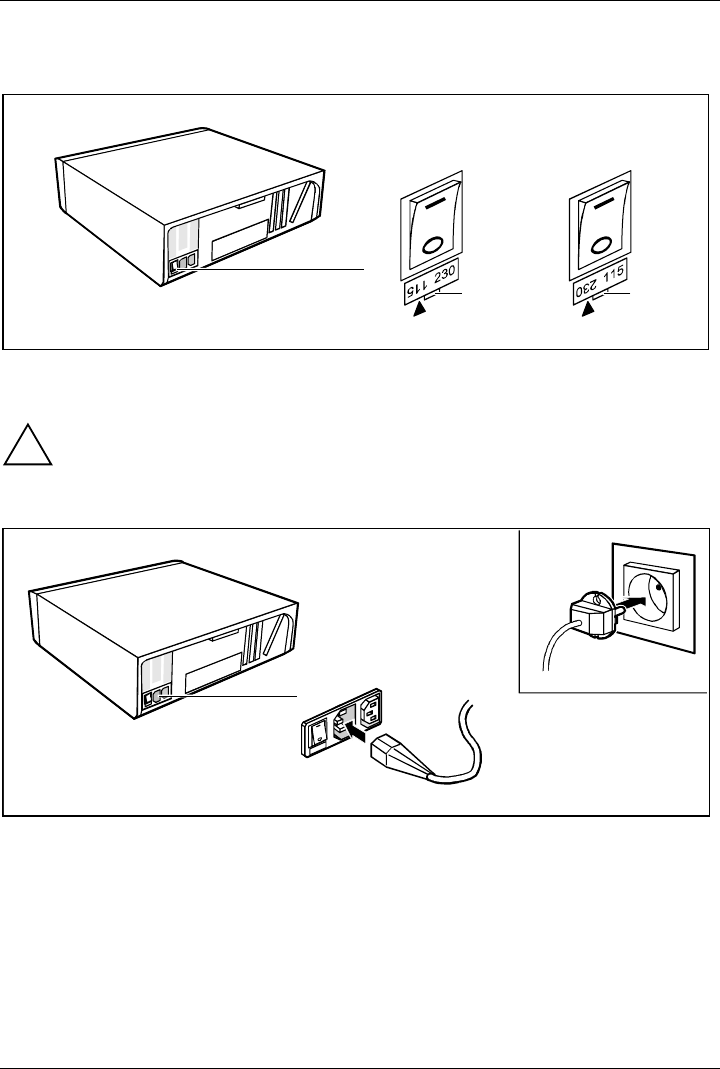
Preparation for use and operation Connecting the PC to the line voltage
14 A26361-K520-Z200-1-7619
Connecting the PC to the line voltage
100 V - 125 V 200 V - 240 V
1 1
1 = Notch for inserting the screwdriver
Ê Check the rated voltage.
!The value marked with an arrow must agree with the local line voltage:
115 = 100 V to 125 V 230 = 200 V to 240 V
If the rated voltage does not agree with the local line voltage, lift out the plug-in unit with a
screwdriver (1), turn it and replace it.
2
1
Ê Plug the system unit's power cable into the system unit (1) and then into the grounded power
outlet (2).
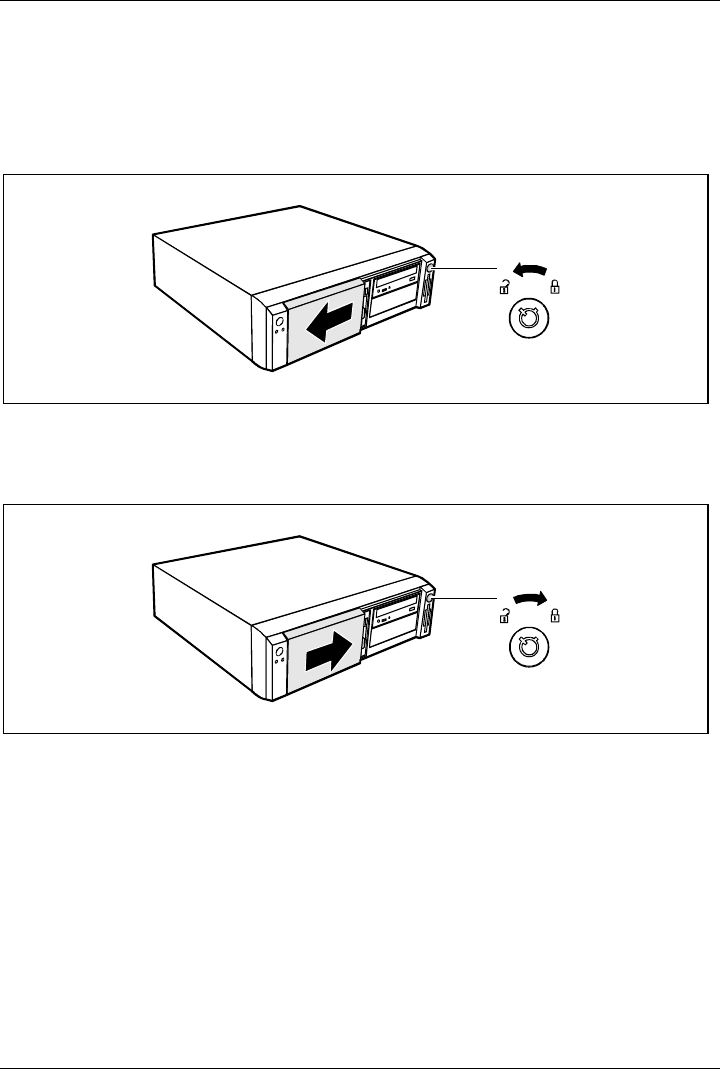
Unlocking/locking the system unit Preparation for use and operation
A26361-K520-Z200-1-7619 15
Unlocking/locking the system unit
With the casing lock you can mechanically lock the system unit, and with the drive cover you can
block access to the drives.
Unlocking the system unit
1
2
Ê Turn the key counterclockwise (1).
Ê Slide the drive cover in direction of the arrow (2).
Locking the system unit
2
1
Ê Slide the drive cover in direction of the arrow (1) and turn the key clockwise (2).
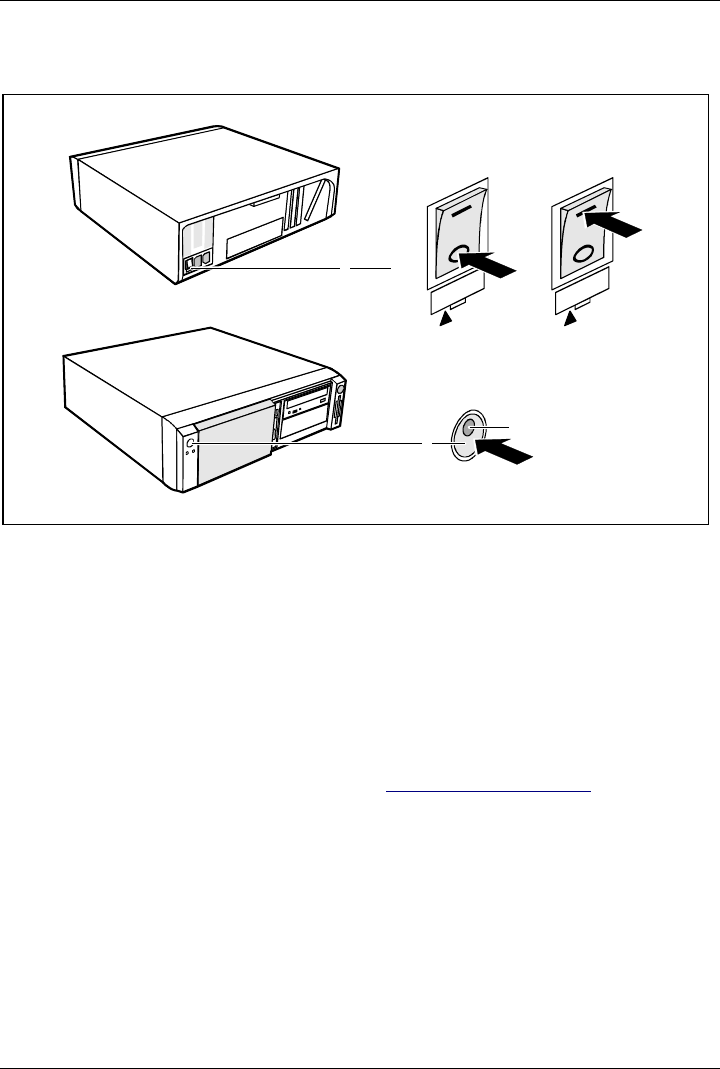
Preparation for use and operation Switching the PC on and off
16 A26361-K520-Z200-1-7619
Switching the PC on and off
1
23
0I
1 = Main switch
2 = ON/OFF switch
3 = Power-on indicator
0 = System unit is switched off
I = System unit is ready-to-operate
System unit is off
The main switch (1) is in position 0, the power-on indicator (3) does not light, and the ON/OFF
switch (2) is disabled.
System unit is ready-to-operate
The main switch (1) is in position I and the power-on indicator (3) lights up orange or flashes
green/orange. In this mode, you can switch the system unit on with the ON/OFF switch (2). The
"ready-to-operate" status corresponds to the "stand-by" status of a TV set. The exact description of
the power-on indicator (3) is contained in the section "Indicators on the system unit".
System unit is on
The main switch (1) is in position I and the power-on indicator (3) lights up green. The system unit
can be switched ready-to-operate with the ON/OFF switch (2).

Switching the PC on and off Preparation for use and operation
A26361-K520-Z200-1-7619 17
Switching on the PC for the first time
If the PC is integrated into a network, the user and server details as well as the network protocol are
required. Contact your network administrator if you have any questions about these details.
When you switch on your PC for the first time the supplied software is set up and configured.
If you require the license number of Windows, you will find it either on a sticker on your PC or
printed on the front cover of the Windows manual provided.
Ê Switch your monitor on.
Ê Switch the system unit on with the ON/OFF switch.
The power-on indicator lights green and the PC is started.
i
While the PC boots, the screen remains dark for up to a minute depending on the system
configuration. To see the start-up messages, you can switch off this standard setting in
the BIOS Setup in the Quiet Boot entry.
Ê Adjust the brightness if necessary (see the Operating Manual for the monitor).
i
Some variants require you to start the software installation by pressing the function key
[F1]
[F1][F1]
[F1].
Once the installation has been started the PC must not be switched off.
You should only reboot the PC during installation if you are requested to do so. Otherwise
the installation will be not be performed correctly. If a fault occurs in the installation the
contents of the hard disk must be completely restored.
Ê During installation follow the instructions on the screen.
Consult the operating system manual if there is anything unclear about the requested input data.
Some system configurations do not include a Windows CD in the delivery package. In this case you
should create a backup copy after installing Windows so that you can restore the hard disk contents
in an emergency.
You need about 40 diskettes for this.
Ê Create Windows diskettes with the MSCSD backup program (create system diskettes) and label
them using the labels supplied.
i
You will find further information about the system, drivers, utilities, updates, and manuals
etc. on the "Drivers & Utilities" CD supplied.

Preparation for use and operation Switching the PC on and off
18 A26361-K520-Z200-1-7619
Switching on the PC
Ê Switch the monitor on (see the Operating Manual for the monitor).
Ê Switch the system unit on with the main switch at the rear of the system unit.
Ê If the power-on indicator lights orange, press the ON/OFF switch at the front of the system unit.
The power-on indicator lights green and the PC is started.
!While the PC boots, the screen remains dark for up to a minute depending on the system
configuration. To see the start-up messages, you can switch off this standard setting in
the BIOS Setup in the Quiet Boot entry.
If you have assigned the system password, you must enter this when requested to do so,
in order to start the operating system.
Switching off the PC
Ê Shut down the operating system Windows properly in the Start menu via the Quit function.
Ê If the operating system does not automatically switch the system unit off, switch the system
unit to ready-to-operate by pressing the ON/OFF switch or turn it off by pressing the main
switch when requested to do so.
If the system unit is ready-to-operate, the power-on indicator lights up orange. The system unit
consumes a minimum of energy and can be switched on by an external device (provided that the
remote-on functionality is set to Enabled in the BIOS Setup).
When the system unit is switched off with the main switch the power-on indicator is dark after
approx. 15 seconds. The system unit no longer uses any power.
i
The main switch and the ON/OFF switch do not disconnect the system unit from the line
voltage. To disconnect the line voltage completely, remove the power plug from the
socket.
Ê Switch the monitor off (see the Operating Manual for the monitor).
Placing a PC (with soft power off function) in a ready-to-operate state by means of software
Prerequisite: Your system must support switching off with software and this functionality must be
enabled in BIOS Setup (Soft Power OFF - Enabled). In addition, the soft off software must be installed
on Windows NT systems.
You can switch your PC ready-to-operate under Windows 9x and Windows NT via the Shutdown the
Computer menu or by using the DeskOff program.
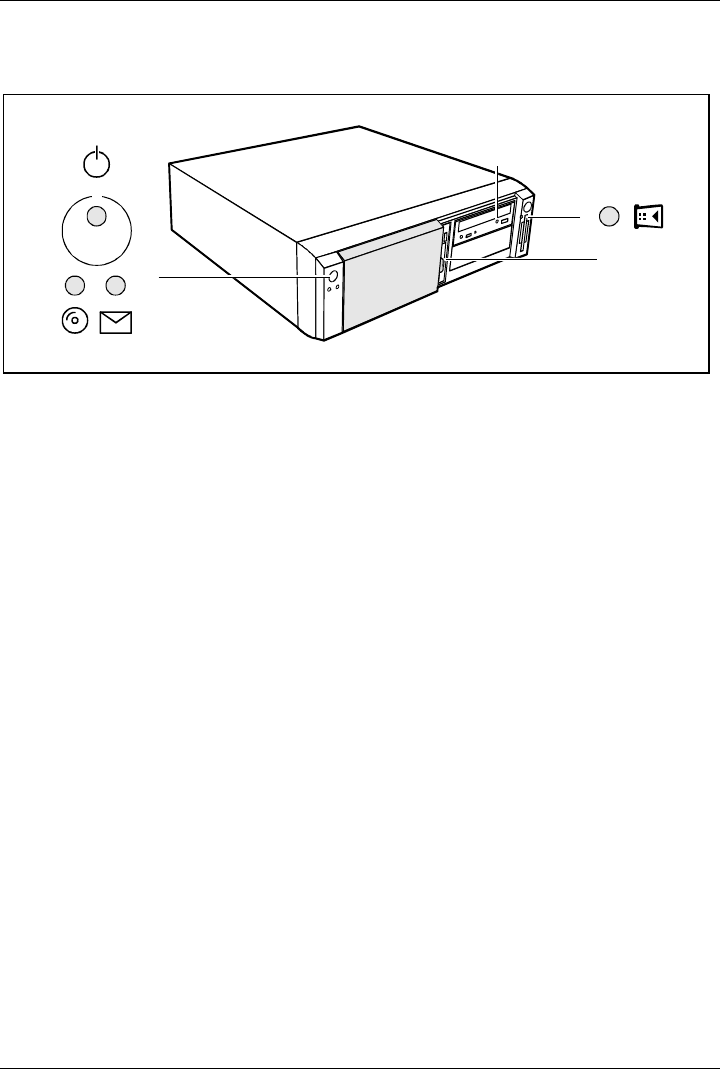
Indicators on the system unit Preparation for use and operation
A26361-K520-Z200-1-7619 19
Indicators on the system unit
23
1
4
5
6
1 = Power-on indicator
2 = Hard disk indicator
3 = Message indicator
4 = CD-ROM indicator
5 = Chipcard reader indicator
6 = Floppy disk indicator
1 - Power-on indicator
− green:
The system unit is on.
− orange:
The system unit is ready-to-operate.
In this mode the PC consumes very little power and can be switched on at the ON/OFF
switch. If the remote-on function is Enabled in the BIOS Setup, the system unit can be
switched on by an incoming message (e. g. fax, telephone call).
− flashes green/orange:
The indicator only flashes on systems which support the ACPI function (Advanced
Configuration and Power Management Interface).
The system unit is in the energy-saving mode (standby). After being switched on with the
ON/OFF switch, the PC returns to the state it was in before the energy-saving mode. In
the energy-saving mode the system unit may not be switched off with the main switch or
disconnected from the mains supply, as this may otherwise result in data loss.
− does not glow:
The system unit is switched off.
2 - Hard disk indicator
The indicator lights up when the hard disk drive of the system unit is accessed.
3 - Message indicator
The display glows or flashes when the system has received a message or has reported a
malfunction. A detailed description can be found in the Technical Manual for the system board.
4 - CD-ROM indicator
The indicator lights up when the CD-ROM drive of the system unit is accessed. You may only
remove the CD when the indicator is dark.
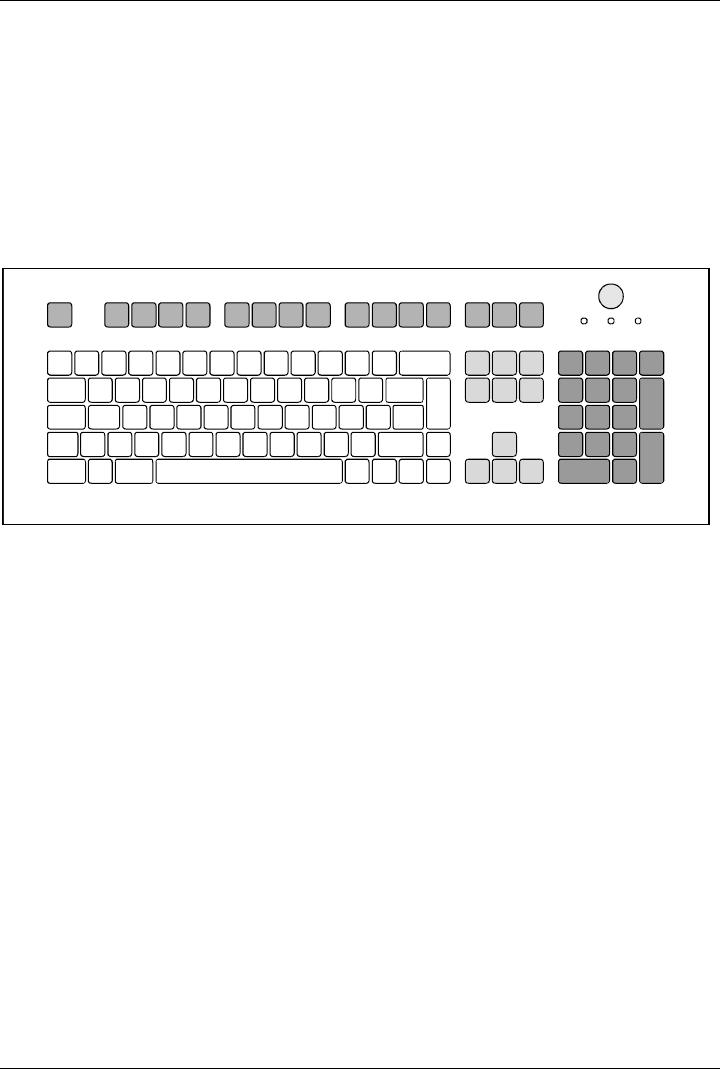
Preparation for use and operation Keyboard
20 A26361-K520-Z200-1-7619
5 - Chipcard reader indicator
The indicator lights up when the chipcard reader is accessed. You may only remove the chipcard
when the indicator is dark.
6 - Floppy disk indicator
The indicator lights up when the floppy disk drive of the system unit is accessed. You may only
remove the floppy disk when the indicator is dark.
Keyboard
1
34
5
2
1 = Function keys
2 = ON/OFF switch (optional)
3 = alphanumeric keypad
4 = Cursor control keys
5 = numeric keypad (calculator keypad)
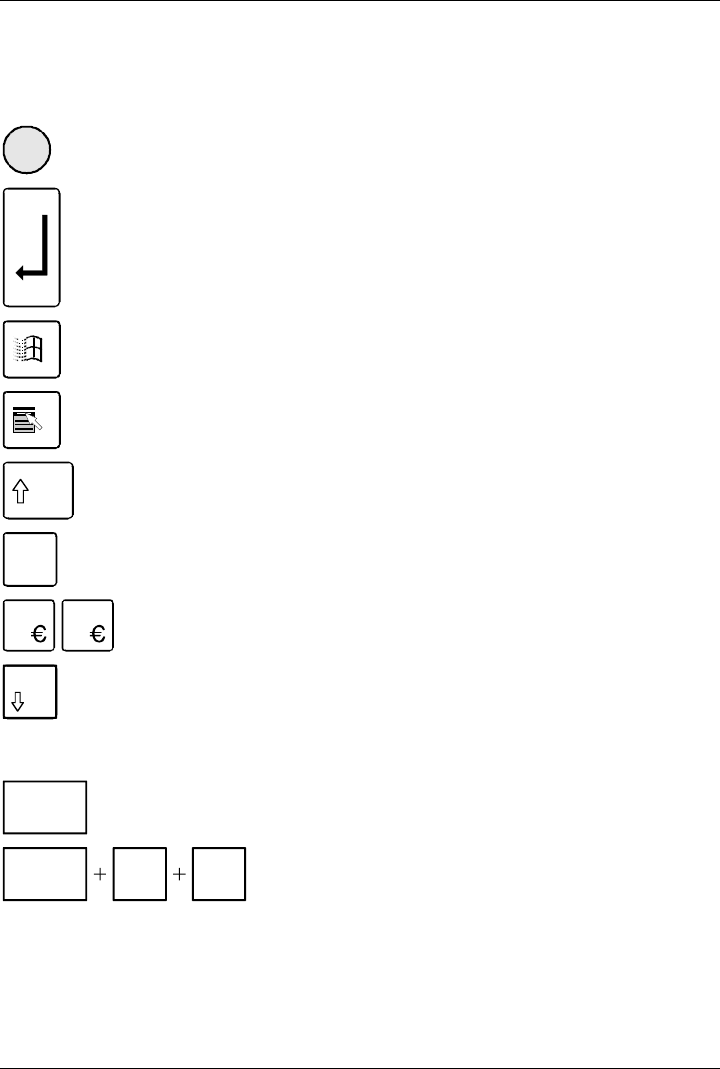
Keyboard Preparation for use and operation
A26361-K520-Z200-1-7619 21
Important keys and key combinations
The following description of keys and key combinations refers to MS Windows. Details of other keys
and key combinations can be found in the documentation of the relevant application program.
ON/OFF switch
Depending on the setting in the BIOS setup, the system can be switched on, off or on
and off with this switch.
Enter key
confirms or starts the marked selection. The enter key is also referred to as the
"Return" key or "Carriage Return".
Start key
invokes the START menu of Windows.
Menu key
invokes the menu for the marked item.
Shift key
enables upper-case letters and the upper key symbols to be displayed.
Alt Gr Alt Gr (e.g. German keyboard)
produces a character shown on the right-hand side of a key (e. g. the character "
\
"
on the key [ß]
[ß][ß]
[ß]).
%
5$
4
Euro key
enables the output of the euro symbol.
Num Num Lock key
by pressing the Num Lock key you switch between the upper- and lower-case levels
of the calculator keypad.
At upper-case level (Num Lock indicator lit) the digit and comma keys are active.
At lower-case level (Num Lock indicator not lit) the cursor control functions are
active in the calculator keypad.
Ctrl Ctrl key
starts key combination actions.
Ctrl Alt Del
Warm boot
restarts your PC. First hold down the [Ctrl]
[Ctrl][Ctrl]
[Ctrl] and [Alt]
[Alt][Alt]
[Alt] key, and
then press the [Del]
[Del][Del]
[Del] key. With Windows 9x the Task Manager
appears first. The warm start is then carried out the second
time.
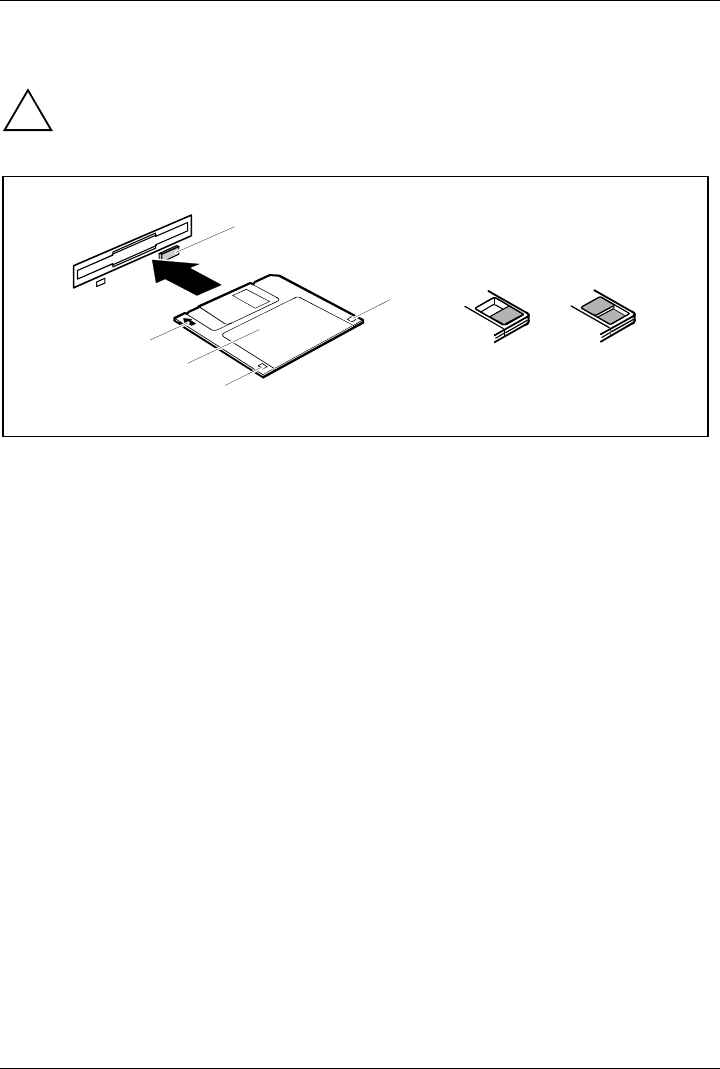
Preparation for use and operation Working with floppy disks
22 A26361-K520-Z200-1-7619
Working with floppy disks
!Follow the instructions supplied by the vendor of the floppy disks.
Never clean the floppy disk drives with cleaning disks. Even just one attempt would
destroy the read/write head in the disk drive within 20 seconds.
3
2
1
5
6
47
1 = Insertion direction
2 = Label area
3 = Write protection tab for a 720 Kbyte or a 1.44 Mbyte floppy disk
4 = Identification of a 1.44 Mbyte floppy disk or write protect tab on a 120 Mbyte floppy disk
5 = Eject button for inserted floppy disks
6 = Floppy disk is write-protected
7 = Floppy disk is not write-protected
Ê To insert a floppy disk, push it into the drive in the insertion direction (1) until it engages. The
label should be facing upward.
Ê To remove the floppy disk, press the eject button (5).
The write-protect slider enables you to protect the data on the floppy disk from inadvertent
overwriting or deletion.
Ê To protect the data on the floppy disk from being overwritten, push the write-protect slider to
position (6). The hole is now visible.
Ê To remove write protection, push the slider to position (7). The hole is now covered.